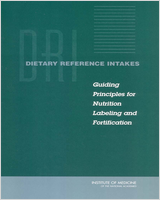NCBI Bookshelf. A service of the National Library of Medicine, National Institutes of Health.
Since 1997, the Institute of Medicine has issued a series of nutrient reference values that are collectively termed Dietary Reference Intakes (DRIs). The DRIs offer quantitative estimates of nutrient intakes to be used for planning and assessing diets. Using the information from these reports, this newest volume in the DRI series focuses on how the DRIs, and the science for each nutrient in the DRI reports, can be used to develop current and appropriate reference values for nutrition labeling and food fortification.
Focusing its analysis on the existing DRIs, the book examines the purpose of nutrition labeling, current labeling practices in the United States and Canada, food fortification practices and policies, and offers recommendations as a series of guiding principles to assist the regulatory agencies that oversee food labeling and fortification in the United States and Canada. The overarching goal of the information in this book is to provide updated nutrition labeling that consumers can use to compare products and make informed food choices. Diet-related chronic diseases are a leading cause of preventable deaths in the United States and Canada and helping customers make healthy food choices has never been more important.
Contents
- THE NATIONAL ACADEMIES
- COMMITTEE ON USE OF DIETARY REFERENCE INTAKES IN NUTRITION LABELING
- FOOD AND NUTRITION BOARD
- Reviewers
- Preface
- Executive Summary
- 1. Introduction
- 2. Overview of Nutrition Labeling in the United States and Canada
- 3. Overview of Food Fortification in the United States and Canada
- 4. A Brief Review of the History and Concepts of the Dietary Reference Intakes
- 5. Guiding Principles for Selecting Reference Values for Nutrition Labeling
- 6. Guiding Principles for the Discretionary Addition of Nutrients to Food
- 7. Data Support and Research Recommendations
- RESEARCH IN SUPPORT OF DETERMINING NUTRIENT REQUIREMENTS
- BIOLOGICAL ENDPOINTS UNDERLYING THE TOLERABLE UPPER INTAKE LEVELS AND INFORMATION ON ADVERSE EFFECTS
- EMPIRICAL RESEARCH TO ASCERTAIN THE IMPACT OF DISCRETIONARY FORTIFICATION
- FOOD COMPOSITION AND DIETARY SUPPLEMENT DATABASES
- CHANGES IN NUTRITION LABELING AND CONSUMER RESEARCH ON ITS USE
- 8 References
- A Biographical Sketches of the Committee
- B Selected Illustrative Calculations Using a Population-Weighted Approach
- C Reference Tables
- D Workshop Programs
Support for this project was provided by the Food and Drug Administration of the U.S. Department of Health and Human Services and the Food Safety and Inspection Service of the U.S. Department of Agriculture under Contract No. 223-01-2460, Task Orders 5 and 8, and by Health Canada under Contract No. H1021-020552/001/SS. The views presented in this report are those of the Institute of Medicine Committee on Use of Dietary Reference Intakes in Nutrition Labeling and are not necessarily those of the funding agencies.
NOTICE: The project that is the subject of this report was approved by the Governing Board of the National Research Council, whose members are drawn from the councils of the National Academy of Sciences, the National Academy of Engineering, and the Institute of Medicine. The members of the committee responsible for the report were chosen for their special competences and with regard for appropriate balance.
- NLM CatalogRelated NLM Catalog Entries
- Dietary Reference IntakesDietary Reference Intakes
- SUGCT succinyl-CoA:glutarate-CoA transferase [Homo sapiens]SUGCT succinyl-CoA:glutarate-CoA transferase [Homo sapiens]Gene ID:79783Gene
- Gene Links for GEO Profiles (Select 119941411) (1)Gene
Your browsing activity is empty.
Activity recording is turned off.
See more...
